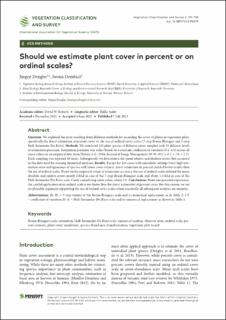Please use this identifier to cite or link to this item:
https://doi.org/10.21256/zhaw-28572| Publication type: | Article in scientific journal |
| Type of review: | Peer review (publication) |
| Title: | Should we estimate plant cover in percent or on ordinal scales? |
| Authors: | Dengler, Jürgen Dembicz, Iwona |
| et. al: | No |
| DOI: | 10.3897/VCS.98379 10.21256/zhaw-28572 |
| Published in: | Vegetation Classification and Survey |
| Volume(Issue): | 4 |
| Page(s): | 131 |
| Pages to: | 138 |
| Issue Date: | Jul-2023 |
| Publisher / Ed. Institution: | Pensoft |
| ISSN: | 2683-0671 |
| Language: | English |
| Subjects: | Braun-Blanquet scale; Estimation; Hult-Sernander-Du Rietz scale; Numerical analysis; Observer error; Ordinal scale; Percent estimate; Plant cover; Simulation; Species abundance; Transformation; Vegetation-plot record |
| Subject (DDC): | 580: Plants (Botany) |
| Abstract: | Question: We explored the error resulting from different methods for recording the cover of plants in vegetation plots, specifically the direct estimation of percent cover vs. the use of ordinal cover scales (7-step Braun-Blanquet and 5-step Hult-Sernander-Du Rietz). Methods: We simulated 121 plant species of different cover, sampled with 13 different levels of estimation precision. Estimation precision was either based on a constant coefficient of variation (0.1–1.0) across all cover values or on empirical data from Hatton et al. (1986, Journal of Range Management 39: 91–92) (× 0.5, × 1.0, × 1.5). Each sampling was repeated 10 times. Subsequently, we determined the mean relative and absolute errors that occurred in the data used for ensuing numerical analyses. Results: Except for few cases with unrealistic settings (very high estimation error and ignorance of species with lower cover values), direct estimation in percent yielded better results than the use of ordinal scales. Based on the empirical values of estimation accuracy, the use of ordinal scales inflated the mean absolute and relative errors nearly 2-fold in case of the 7-step Braun-Blanquet scale and about 1.5-fold in case of the Hult-Sernander-Du Rietz scale if only considering cover values above 1%. Conclusions: From our personal experience, the careful application of an ordinal scale is not faster than the direct estimation of percent cover. For this reason, we see no plausible argument supporting the use of ordinal cover scales when essentially all subsequent analyses are numeric. |
| URI: | https://digitalcollection.zhaw.ch/handle/11475/28572 |
| Fulltext version: | Published version |
| License (according to publishing contract): | CC BY 4.0: Attribution 4.0 International |
| Departement: | Life Sciences and Facility Management |
| Organisational Unit: | Institute of Natural Resource Sciences (IUNR) |
| Appears in collections: | Publikationen Life Sciences und Facility Management |
Files in This Item:
| File | Description | Size | Format | |
|---|---|---|---|---|
| 2023_Dengler-Dembicz_Estimation-of-plant-cover-percent-ordinal-scales_VCS.pdf | 508.17 kB | Adobe PDF |  View/Open |
Show full item record
Dengler, J., & Dembicz, I. (2023). Should we estimate plant cover in percent or on ordinal scales? Vegetation Classification and Survey, 4, 131–138. https://doi.org/10.3897/VCS.98379
Dengler, J. and Dembicz, I. (2023) ‘Should we estimate plant cover in percent or on ordinal scales?’, Vegetation Classification and Survey, 4, pp. 131–138. Available at: https://doi.org/10.3897/VCS.98379.
J. Dengler and I. Dembicz, “Should we estimate plant cover in percent or on ordinal scales?,” Vegetation Classification and Survey, vol. 4, pp. 131–138, Jul. 2023, doi: 10.3897/VCS.98379.
DENGLER, Jürgen und Iwona DEMBICZ, 2023. Should we estimate plant cover in percent or on ordinal scales? Vegetation Classification and Survey. Juli 2023. Bd. 4, S. 131–138. DOI 10.3897/VCS.98379
Dengler, Jürgen, and Iwona Dembicz. 2023. “Should We Estimate Plant Cover in Percent or on Ordinal Scales?” Vegetation Classification and Survey 4 (July): 131–38. https://doi.org/10.3897/VCS.98379.
Dengler, Jürgen, and Iwona Dembicz. “Should We Estimate Plant Cover in Percent or on Ordinal Scales?” Vegetation Classification and Survey, vol. 4, July 2023, pp. 131–38, https://doi.org/10.3897/VCS.98379.
Items in DSpace are protected by copyright, with all rights reserved, unless otherwise indicated.